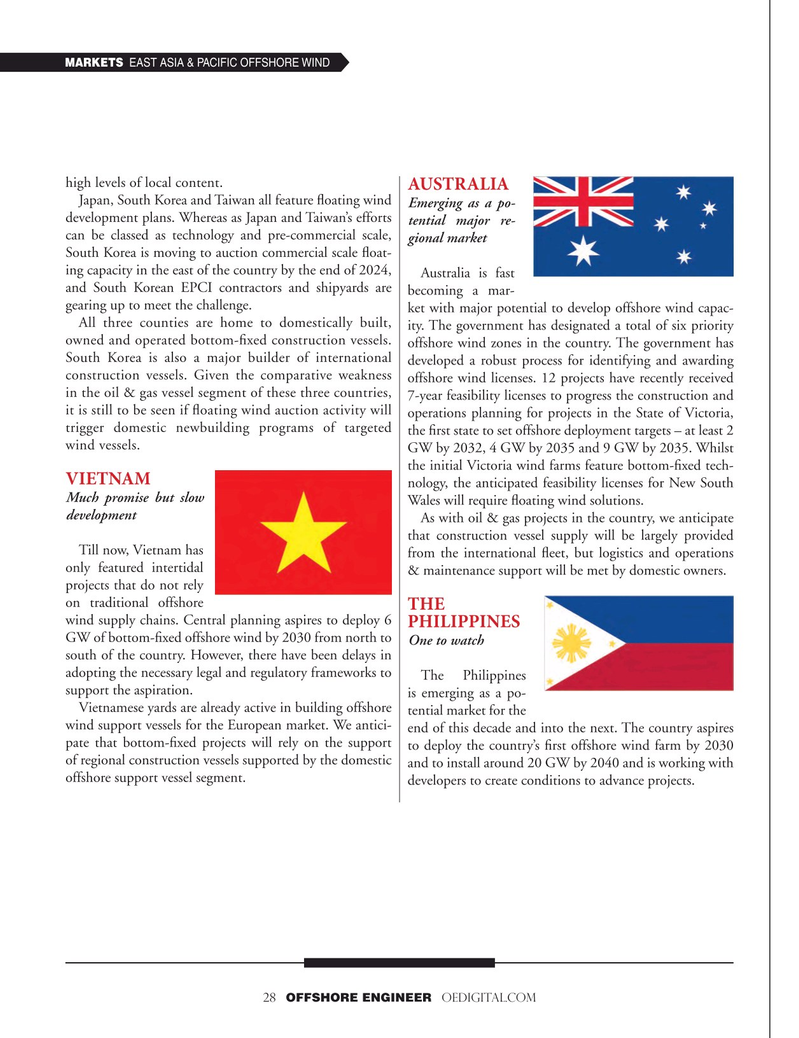
Page 28: of Offshore Engineer Magazine (Jul/Aug 2024)
Read this page in Pdf, Flash or Html5 edition of Jul/Aug 2024 Offshore Engineer Magazine
MARKETS EAST ASIA & PACIFIC OFFSHORE WIND high levels of local content.
AUSTRALIA
Japan, South Korea and Taiwan all feature foating wind Emerging as a po- development plans. Whereas as Japan and Taiwan’s efforts tential major re- can be classed as technology and pre-commercial scale, gional market
South Korea is moving to auction commercial scale foat- ing capacity in the east of the country by the end of 2024,
Australia is fast and South Korean EPCI contractors and shipyards are becoming a mar- gearing up to meet the challenge.
ket with major potential to develop offshore wind capac-
All three counties are home to domestically built, ity. The government has designated a total of six priority owned and operated bottom-fxed construction vessels. offshore wind zones in the country. The government has
South Korea is also a major builder of international developed a robust process for identifying and awarding construction vessels. Given the comparative weakness offshore wind licenses. 12 projects have recently received in the oil & gas vessel segment of these three countries, 7-year feasibility licenses to progress the construction and it is still to be seen if foating wind auction activity will operations planning for projects in the State of Victoria, trigger domestic newbuilding programs of targeted the frst state to set offshore deployment targets – at least 2 wind vessels.
GW by 2032, 4 GW by 2035 and 9 GW by 2035. Whilst the initial Victoria wind farms feature bottom-fxed tech-
VIETNAM nology, the anticipated feasibility licenses for New South
Much promise but slow
Wales will require foating wind solutions.
development
As with oil & gas projects in the country, we anticipate that construction vessel supply will be largely provided
Till now, Vietnam has from the international feet, but logistics and operations only featured intertidal & maintenance support will be met by domestic owners.
projects that do not rely on traditional offshore
THE wind supply chains. Central planning aspires to deploy 6
PHILIPPINES
GW of bottom-fxed offshore wind by 2030 from north to One to watch south of the country. However, there have been delays in adopting the necessary legal and regulatory frameworks to
The Philippines support the aspiration.
is emerging as a po-
Vietnamese yards are already active in building offshore tential market for the wind support vessels for the European market. We antici- end of this decade and into the next. The country aspires pate that bottom-fxed projects will rely on the support to deploy the country’s frst offshore wind farm by 2030 of regional construction vessels supported by the domestic and to install around 20 GW by 2040 and is working with offshore support vessel segment. developers to create conditions to advance projects.
28 OFFSHORE ENGINEER OEDIGITAL.COM

 27
27

 29
29